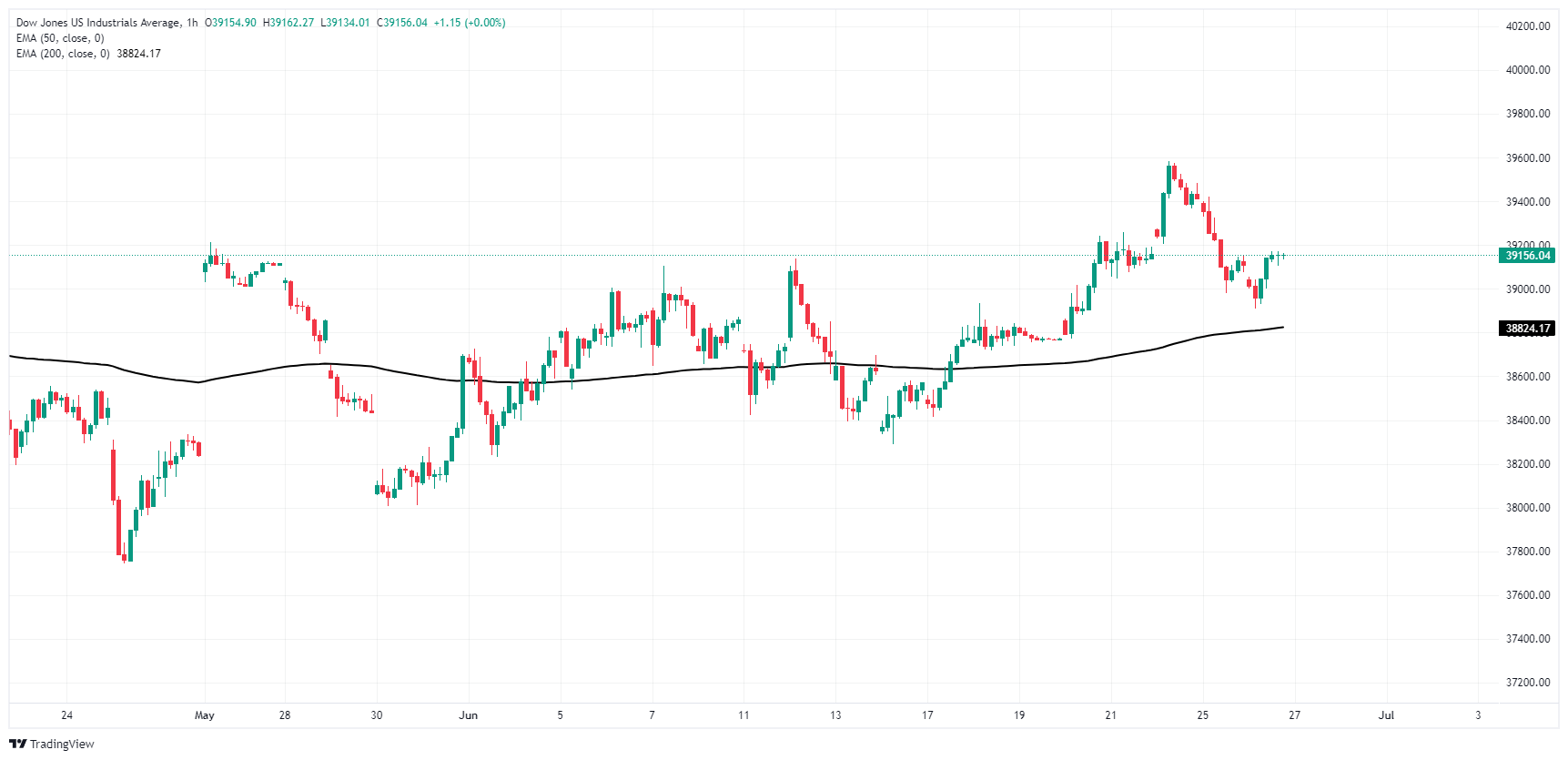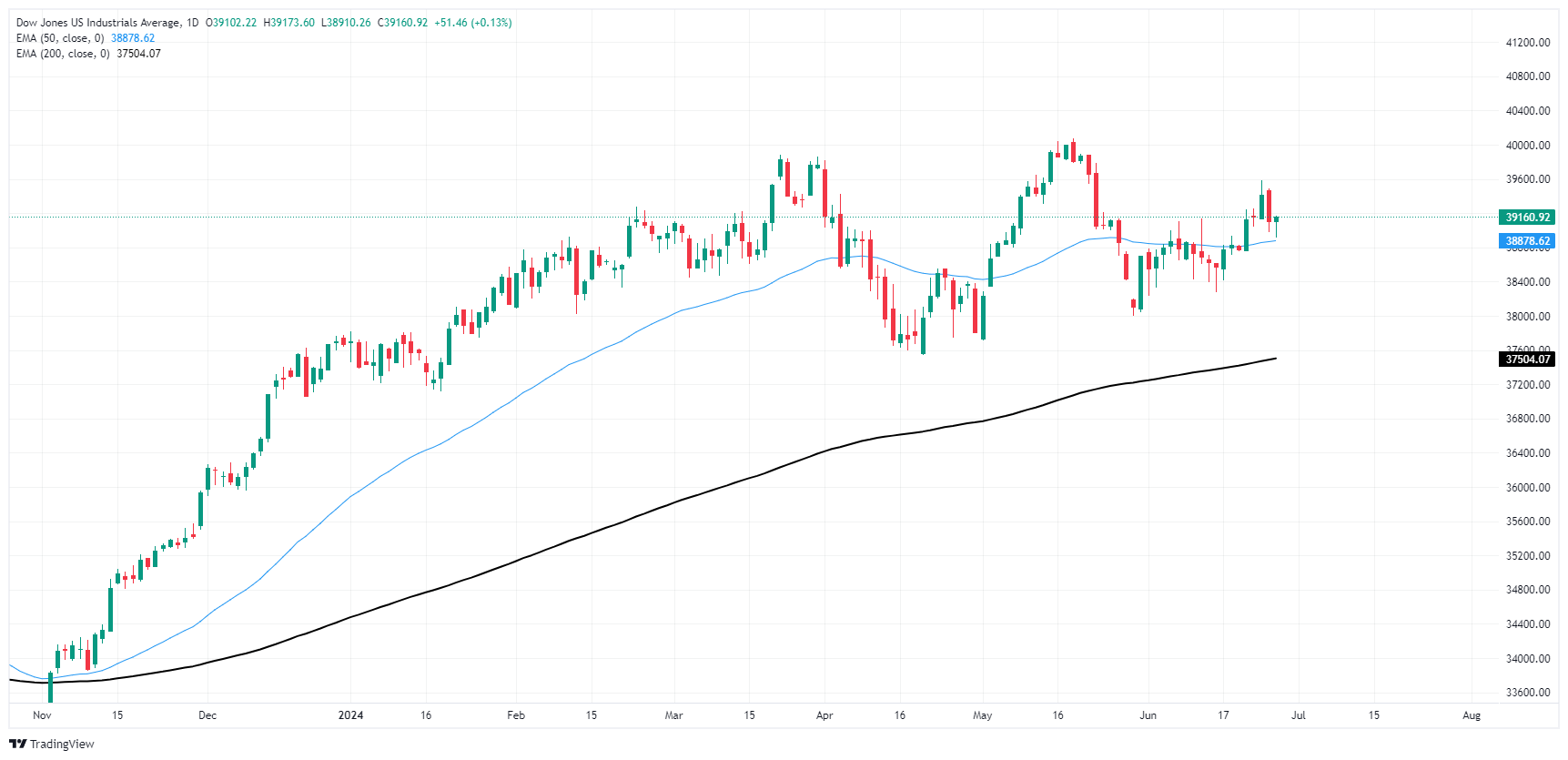- The Dow Jones index remains in the 39,000.00 area amid calm mid-week markets.
- Fed comments continue to pressure rate cut hopes.
- Investors are preparing to wait for key data on Thursday and Friday.
He Dow Jones Industrial Average (DJIA)) remains just above 39,000.00 in tepid trading Wednesday, as markets prepare to await key data in the second half of the trading week. Federal Reserve (Fed) officials have repeatedly signaled the need for patience with policy rates. The US central bank continues to look for firmer signs that inflation will continue to decline to the Fed’s 2% annual target. The notable lack of economic slowdown and a still tight labor market leave the Fed with little need to rush to cut rates. Several Fed officials have warned there may be no rate cuts in 2024, while the Fed’s median dot plot of rate expectations suggests only a quarter-point cut for the year.
The notable lack of data on Wednesday leaves investors uneasy and awaiting a number of key US data points scheduled for release on Thursday and Friday. US durable goods orders, a revision of US first quarter gross domestic product (GDP) and initial jobless claims are due on Thursday. Friday will wrap up the trading week with a new release of US Personal Consumption Expenditure (PCE) Price Index inflation figures for May.
Investors with hopes pinned on at least a quarter-point rate cut from the Fed in September will be looking for soft but not too soft U.S. economic figures. Too good a result means the Fed will be even less likely to cut rates early, while too bad a data calendar will mean the U.S. is headed for a recession, leaving rate-cut-hungry markets dreaming of a happy medium.
Dow Jones News
The Dow Jones rises barely 30 points as it enters the final stretch of Wednesday’s US market session. The major stock index holds steady thanks to firm gains in market favorites, but most of the stocks that make up the Dow Jones are in the red on Wednesday, with two-thirds of stocks listed slightly in the red.
Amazon.com Inc. (AMZN) rose nearly 4.5% on Wednesday, approaching $195.00 per share, while Apple Inc. (AAPL) struggles to keep pace, rising 2.3% to $214.00 per share. On the downside, Amgen Inc. (AMGN) and Travelers Companies Inc. (TRV) fall about 1.7% each, with Amgen falling below $315.00 per share and Travelers Companies falling to $205.00 per share.
Dow Jones Technical Outlook
The Dow Jones remains within the touch range of the previous day’s closing bids near 39,100.00 on Wednesday. The DJIA remains below last week’s peak near 39,600.00, but a near-term bottom has been set at Wednesday’s early lows just above 38,900.00.
The daily candlesticks continue to hold just above the 50-day EMA at 38,878.00 as bidders attempt to drag the large-cap index back toward the all-time highs set in May, just north of the zone. of 40,000.00.
Dow Jones Five Minute Chart
Dow Jones Daily Chart
The Dow Jones
The Dow Jones Industrial Average, one of the world’s oldest stock indices, is made up of the 30 most traded securities in the United States. The index is weighted by price rather than capitalization. It is calculated by adding the prices of the securities that comprise it and dividing them by a factor, currently 0.152. The index was founded by Charles Dow, also founder of the Wall Street Journal. In recent years it has been criticized for not being sufficiently representative, since it only follows 30 companies, unlike broader indices such as the S& P 500.
There are many factors that drive the Dow Jones Industrial Average (DJIA). The main one is the aggregate performance of its component companies, revealed in quarterly corporate earnings reports. US and global macroeconomic data also contribute, influencing investor sentiment. The level of interest rates, set by the Federal Reserve (Fed), also influences the DJIA, as it affects the cost of credit, on which many companies largely depend. Therefore, inflation can be a determining factor, as well as other parameters that influence the Federal Reserve’s decisions.
The Dow Theory is a method for identifying the main trend of the stock market developed by Charles Dow. A key step is to compare the direction of the Dow Jones Industrial Average (DJIA) and the Dow Jones Transportation Average (DJTA) and only follow trends where they are both moving in the same direction. Volume is a confirmation criterion. The theory uses elements of maximum and minimum analysis. The Dow theory proposes three phases of the trend: accumulation, when the smart money begins to buy or sell; public participation, when the general public joins the trend; and distribution, when the smart money abandons the trend.
There are several ways to trade the DJIA. One is to use ETFs that allow investors to trade the DJIA as a single security, rather than having to buy shares of all 30 companies that comprise it. A prominent example is the SPDR Dow Jones Industrial Average ETF (DIA). Futures contracts on the DJIA allow traders to speculate on the future value of the index, and options provide the right, but not the obligation, to buy or sell the index at a predetermined price in the future. Mutual funds allow investors to purchase a portion of a diversified portfolio of DJIA securities, providing exposure to the overall index.
Source: Fx Street
I am Joshua Winder, a senior-level journalist and editor at World Stock Market. I specialize in covering news related to the stock market and economic trends. With more than 8 years of experience in this field, I have become an expert in financial reporting.







